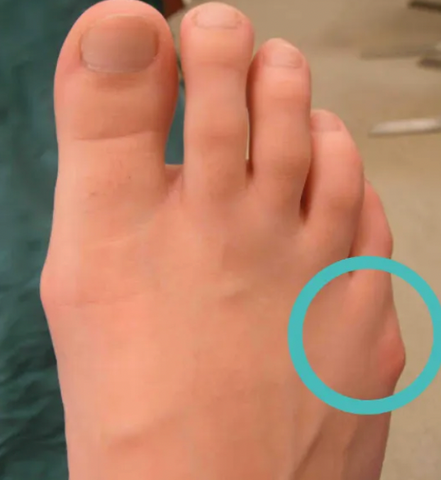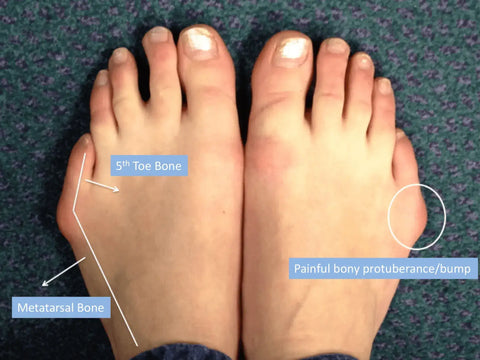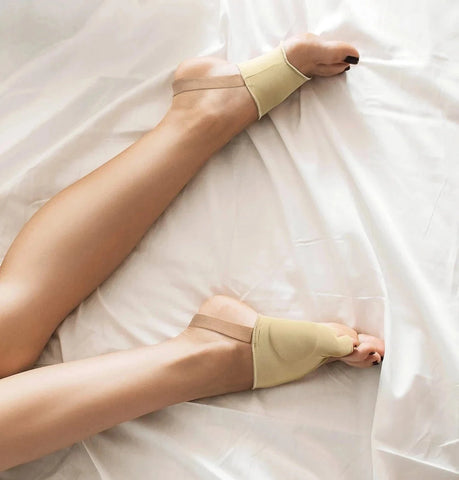How to Manage an Early Stage Pinky Toe Bunion: Expert Advice

In this article, we will delve into the topic of early stage pinky toe bunions in detail. We will explain what causes them, how to recognize the symptoms, and what treatment options are available.
What Are Early Stage Pinky Toe Bunions?
A bunion is a bony bump that forms at the joint where two bones meet. It usually occurs at the base of the big toe, but can also affect the pinky toe. When a bunion develops on the pinky toe, it is called a pinky toe bunion (also known as a bunionette) or a tailor’s bunion. This name comes from the fact that tailors used to sit cross-legged, which put pressure on the outside of their feet and led to the development of these bumps.
Early stage pinky toe bunions are those that have just started to form. At this stage, the bump is still small and not very noticeable. However, it can cause pain and discomfort, especially when wearing tight shoes or standing for long periods. If left untreated, early stage pinky toe bunions can progress and become more severe over time.

What Causes Early Stage Pinky Toe Bunions?
Bunions (in general) form as a result of a misalignment in the foot. Bunions come about when pressure (either external or internal) forces the muscles, joints, and tendons in the foot into an unnatural position. This, in turn, causes the formation of a bony mass known as a bunion. Bunionettes occur for the same reasons as traditional bunions –– with the crucial difference being the pressure is placed on the side of the foot near the small toe.
How Are Early Stage Pinky Toe Bunions Treated?
There are several ways to manage the symptoms of an early stage pinky toe bunion:
- Orthopedic Bunionette Pain Relief Sleeves: Wearing bunionette sleeves can cut out the rubbing that can often occur and stop the progression of the bump. These sleeves are not capable of removing bunions, but they are very effective and can cut down on pain from bunionettes. Learn More
Prevention score: 9/10
Pain relief score: 10/10
Long-term solution: 10/10
- Ice Packs: Applying ice packs to your foot for 5 to 10 minutes up to 3 times per day can help to relieve pain.
- Comfortable Footwear: Wearing shoes that are flexible and have a wide toe box can help to prevent the bunion from rubbing against your shoe.
- Over-the-Counter Medications: Taking over-the-counter medications to fight inflammation, such as Ibuprofen, can help to manage pain.
- Toe, Calf Stretches: Daily exercises can be a great help in managing your Tailor’s bunion and keeping it from getting worse. Aim to do these exercises once or twice a day, about four to five times a week. Here are some exercises you can try:
- Toe exercises: Sit with your legs stretched out in front of you and your toes pointing up. Try to spread your toes and hold the position for 15 seconds, then relax. Do this several times for each foot.
- Toe curls: While sitting with your legs stretched out, curl your toes, hold for a second, and then relax. Repeat this several times on both feet. You can also do this exercise while sitting with your feet on a towel. Try to pull the towel towards you by curling your toes.
- Foot stretch: Sit down and cross one leg over the other, placing your foot on the opposite knee. Gently stretch your forefoot backward with your hand. You should feel the stretch in the sole of your foot. Hold this for 15-20 seconds and then release. Do this three times for each foot, about two to three times a day.
Should You Correct a Taylor's Bunion During Regular Bunion Surgery?
When it comes to bunion surgery, many patients wonder if they should address a Taylor's bunion (also known as a bunionette) at the same time as their regular bunion, even if it's not causing pain. Here's what you need to know:
The Case for Preventative Correction
- Future-Proofing: Even if your Taylor's bunion isn't causing pain now, correcting it during your regular bunion surgery can prevent potential issues down the line.
- Single Recovery Period: Addressing both issues at once means you only have to go through one recovery period instead of potentially two separate ones.
- Balanced Foot Structure: Correcting both bunions can lead to a more balanced foot structure overall, potentially improving your gait and reducing the risk of other foot problems.
Considerations
- Severity: The decision often depends on the severity of the Taylor's bunion, even if it's not painful.
- Overall Foot Health: Your surgeon will consider your entire foot structure when making recommendations.
- Recovery Time: Correcting both bunions might slightly extend your recovery period.
While it's common to address Taylor's bunions during regular bunion surgery, the decision should be made on a case-by-case basis.
Pinky Toe Bunion Treatment Options in Each State:
-
South Carolina:
- The Physicians Footcare team offers bunion treatment in various locations including Aiken, Beaufort, Cayce, Columbia, and others.
- Another option is the MUSC Orthopedics - Foot & Ankle Surgery in Charleston, which provides treatments for issues such as arthritis, bunions, and other deformities.
-
North Carolina:
- For bunion treatment in North Carolina, you can consider InStride Capital Foot and Ankle Centers or the MUSC Health Orthopedics.
-
Florida:
- The Florida Medical Clinic offers a variety of surgical bunion treatment options.
- Another option is the Florida Orthopaedic Institute, which provides both surgical and non-surgical treatments.
-
Michigan:
- The Bunion Doctors in Grand Rapids offer bunion treatment.
- Another option is the MiFoot clinic, which offers minimally invasive foot surgery.
-
Mississippi:
- The Foot Specialists of South Mississippi in Ocean Springs offer full-service medicine and surgery of the foot and ankle.
-
Texas:
- The Bunion Institute in Los Angeles offers minimally invasive surgery for bunions.
- In Texas, the California Foot and Ankle Clinic in Riverside and Rancho Cucamonga also provides innovative bunion treatment options.
-
Ohio:
- The Cleveland Clinic offers comprehensive care for all adult foot and ankle problems, including deformity correction and arthritis.
- They also provide bunion surgery.
-
California:
- The Bunion Institute offers a minimally invasive alternative for bunion treatment.
- The University of California also provides specialized care for foot and ankle conditions.
-
Colorado:
- The Bunion Cure offers a minimally invasive alternative that gets you back on your feet faster and safer than traditional options.
- The Foot and Ankle Center of the Rockies also provides treatment for bunions.
Conclusion
Early stage pinky toe bunions are a common foot condition that can cause significant discomfort and affect your daily activities. However, with appropriate treatment and care, you can manage the symptoms and prevent the condition from getting worse. If you notice a bunionette, it’s important to take action quickly. With the right care, you can keep your feet healthy and pain-free.
Sources
- American Academy of Orthopaedic Surgeons (AAOS). "Bunions." OrthoInfo, 2019. https://orthoinfo.aaos.org/en/diseases--conditions/bunions/
- American College of Foot and Ankle Surgeons. "Tailor's Bunion (Bunionette)." FootHealthFacts.org, 2018. https://www.foothealthfacts.org/conditions/tailor-s-bunion-(bunionette)
- Harvard Health Publishing. "What to do about bunions." Harvard Medical School, 2021. https://www.health.harvard.edu/pain/what-to-do-about-bunions
- Mayo Clinic Staff. "Bunions - Symptoms and causes." Mayo Clinic, 2021. https://www.mayoclinic.org/diseases-conditions/bunions/symptoms-causes/syc-20354799
Expert Quotes
"Early intervention in bunionette treatment is crucial. Conservative treatments like proper footwear and orthotic devices can help prevent progression of the deformity." - Dr. James Christina, Executive Director, American Podiatric Medical Association
"While bunionettes may seem minor compared to traditional bunions, they can cause significant discomfort and should be addressed promptly to prevent worsening." - Dr. Norman Turner, MD, Orthopedic Surgeon, Mayo Clinic
FAQs
- What is a pinky toe bunion? A pinky toe bunion, also known as a bunionette, is a bony bump that forms on the joint at the base of the little toe.
- How can I prevent a pinky toe bunion from worsening? Wearing comfortable shoes, using bunionette sleeves, and performing regular foot exercises can help prevent worsening.



